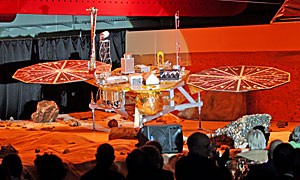The Phoenix Mars Lander, the UA’s project in collaboration with NASA, got a warm welcome Friday as it was unveiled to the public for the first time at a dinner celebration.
The lander, which was tucked away behind a curtain and out of view of Friday’s audience, was watched over by a cartoon cutout of Marvin the Martian, a cardboard reminder of the signs of alien life scientists hope to find using the lander.
The project, which will cost $385 million and years of work, will be directed primarily from the Lunar and Planetary Laboratory near campus.
Rigel Woida, an optical sciences senior and engineer on the Phoenix project, said the lander got its name because it is a reworking of another Mars mission that was scrapped in 2001.
“”It’s almost like it’s this one spacecraft that we’ve had to do 1 1/2 times with the redesign,”” Woida said.
Representatives from some of the UA’s partners in the project, including the Canadian Space Agency and Lockheed Martin Corp., attended the unveiling.
President Robert Shelton was also on hand Friday night, and he said he was very proud of the UA scientists for the work they had been doing.
“”It’s a tribute to the people at this university,”” Shelton said. “”We are going to use this mission shamelessly in bragging about the University of Arizona.””
“”It’s like sending your robotic car to get groceries for you and having to program it all in advance.””
– Peter Smith,
senior research scientist and the mission’s lead scientist
Gail Burd, associate dean of the College of Science, said she is very proud of the project and never misses the opportunity to bring it up in the effort to attract new students.
“”When I try to recruit kids, I say, ‘Look at this, you could be involved in this,'”” Burd said.
Peter Smith, a senior research scientist and the mission’s lead scientist, said that about 300 people from the UA are working on the project.
Before the working model of the Mars Lander was revealed to the public, Smith presented the audience with a short, computer-animated movie of what the scientists expect to happen when they send their robot to the red planet.
When workers finally pulled back the curtains, speakers blared Beethoven’s “”Fifth Symphony”” and the crowd roared in applause. Some audience members gave a standing ovation.
The machine itself stood atop a large platform made to resemble the Martian landscape.
Large solar panels flared on both sides of the machine, which had a multitude of instruments on its top.
One of the instruments, Smith said, is a camera with stereovision, meaning it has two lenses side by side that capture images as they might look to a set of human eyes.
Another instrument, which Smith called the machine’s “”nose,”” is similar to an oven that bakes samples from the Martian landscape and analyzes the vapors that result.
Smith said the mission will send the lander to an area of Mars closer to the north pole of the planet, where scientists have detected large areas of ice.
Previous missions have only visited the equatorial region on Mars.
“”It’s the difference between landing in the Sahara and landing in the Arctic,”” Smith said. “”We will be the first ones to explore (this area).””
Smith said designing the robot and the mission has been a difficult task.
“”It’s like sending your robotic car to get groceries for you and having to program it all in advance,”” Smith said.
The lander is slated to launch on a rocket in August 2007, and 10 months later – around Memorial Day 2008 – it will touch down on the surface of Mars.
One of the main goals of the mission is to investigate water on Mars and the possibility that life exists or has ever existed on the neighboring planet, according to a NASA flier at Friday’s event.









